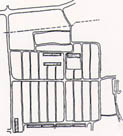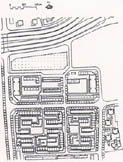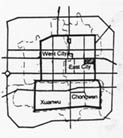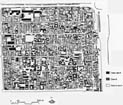Like all political and economic aspects in China, the issues concerning the housing renewal program were changing fast. The program itself, given the rapidly changing context, inevitably kept readjusting.
From the beginning, the objectives of the renewal program were wide and varied. The main players in the renewal process were district governments and the development enterprises. Other than the objectives of the municipal government, various district governments intended to take advantage of the renewal projects to pursue local economic prosperity. And the development and construction compa nies involved wanted to make profit. Thus the wishful thinking that development in new districts could cross-subsidize the renewal projects never materialized. Rather developers insisted that each renewal project yield a profit or at least balance itself.
4.1 Stage One Projects
The projects in Stage One shared some common characteristics which were not found in the pilot projects. Generally, the parcels, which were located mainly along the Second Ring Road, were larger 1 and accessed easily to high capacity infrastructure. Because of their proximity to the major thorough fares, a larger portion of built space could be converted for commercial purposes. And due to their distance from the city center, the height limitation was less strict so new buildings were higher and more densely built (Abramson, 1994).
It was interesting to note why site size needed to be large. In 1986, there came a regulation on the size of development or redevelopment lots in the Old City, that a minimal size of four hectares was required for housing development (Wu Jiang, 1989). Why so? Because since 1974, work -units had been permitted to build housing within their compounds. Since then, a lot of residential buildings, at the beginning mostly four- to five-story walk-up slabs and later even some high-rise apartments, were built in the Old City by dismantling one-story courtyard houses or using small parcels of empty space in their compounds. Many of the compounds that had this potential used to be the houses of noble families possessing large courtyards and gardens, arrayed in the central area. Since 1980, walk-up slabs were built wherever there was space, because land became more and more scarce2. This placement of buildings totally disregarded the spatial composition and features of the old capital (Dong Guangqi, 1994).
Further, these buildings were built within the space under the control of individual work-unit, which made no sense from a regional development point of view. In fact, these miscellaneously built blocks undermined the optimization of regional planning, and in many cases, hampered the renewal of some dilapidated areas and impeded efficient improvement of infrastructure.
The third reason was that this sporadic redevelopment contradicted with the principle of compre hensive development, in which along with the development of housing, a "coordinated set of new public amenities" (pei tao she shi in Chinese) to service the new neighborhood must be provided as well. Individual work-units were only concerned about their own area, and the ques tion of larger facilities such as kindergarten and primary school etc. was beyond their scope. Given the lack of many basic facilities in the broader region, the comprehensive development policy required the redevelopment parcels to be of substantial size (Abramson, 1994).
The experimental nature of the three pilot projects required them to be conservative in size. However criticisms after implementation were based mainly upon their insufficient supply of basic utilities, which indeed resulted from their small scope. Because all of the three projects were in the heart of old residential super-blocks, it was difficult for them to get access to the high capacity infrastructure pipelines installed in the major arteries. Ju-er Hutong resolved the heating problem through a tough negotiation with an adjacent factory, while Dongnanyuan could only leave the space for future installation. Chunfeng Hutong, a Stage One project which was a small parcel located in the heart of a block, also encountered difficulties in improving basic facilities (Dong Lizhu, 1992).

Based on these considerations, the projects in Stage One were of larger size. The municipal planning officials used the major road system to outline the parcel of each project, which not unusually comprised a whole super-block. Some cases, such as Jishikou and Fahuasi sites, were as large as 16 to 20 hectares, even larger than some suburban 'green field' projects. Although Ju-er hutong and Xiaohoucang were the models for subsequent projects in the Old City, in such a large scale, the incremental, resident oriented approach was simply impossible.
4.1.1 Case Study One: Huaibaishu - Xuanwu district
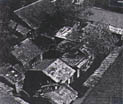
Huaibaishu was located in the western edge of the old Outer City, besides the Second Ring Road in Xuanwu district. It contained about 2,000 households with 6,751 residents covering an area of 11.41 hectares. The site was formerly a camp for imperial troops in Qing Dynasty and later turned into a congested neighborhood for the urban poor. The con struction of renewal projects started in October 1990 and finished in January 1992. 98% of the original residents was rehoused on site after renewal (Abramson, 1994).
Financing:
For the first phase, financial balance was difficult to achieve because all the land was used for residen tial purposes and the on-site relocation rate was high. The preferential selling prices to original resi dents were much lower than those of the market prices. Original households could buy their apart ments at subsidized price of 308 Yuan/m2 if paid all at once, or 380 Yuan in two installments, while the market price was 6,000 to 7,000 Yuan/m2. Although the dwelling units sold on the market were of better quality, they were still walk-up flats. This disparity in prices could not be justified. Even though the selling prices offered to the original households were so heavily subsidized, only five percent of the original residents opted to buy their units (Broudehoux, 1994, p.82). Most returned as tenants, whose rent, though readjusted, still could not even cover the maintenance cost.
To make the project financially self-sustaining, the developer employed two strategies. One was to increase gain, mainly through increasing the FAR, by building extra floor space which could be sold at much higher market price. The developer also offered a bonus to induce people to move out, but the majority of the residents preferred to stay because of its convenient location. The other was to reduce expenditure for rehousing units: minimizing the floor space, using low quality materials and providing minimal facilities. These corner cutting measures resulted in poor construction quality.
Project Features:
According to the designers of this project, the site plan and housing design was mainly to meet the developer's demand for higher FAR (Liu, Yang & Wang, 1991). The project is composed of four- to six-story walk-ups. The spaces in between north-south-facing buildings barely satisfied the requirement for sunlight. Dwelling units with east-west orientation amounted to one third in the first phase. The unit layout was long and narrow with a public stairway in the middle. The roofs pitched down two stories on the north side in the angle of the winter solstice sun. All these design features aimed to reach a higher FAR. On the other hand, the poor building quality was obvious. Only two years after occupancy, the exterior finish had already largely deteriorated and the neighborhood was showing signs of decay. Although big old trees were preserved, the open spaces were not actively utilized because of their poor furnishing.
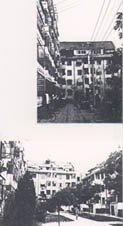
Improper planning and design also contributed to the poor living environment. Although the designer acknowledged that the design principles came from the traditional housing type, by retaining the former basic circulation network, public courtyards, and old trees (Liu, Yang & Wang, 1991), yet human scale was lost in the sheer size of the project. The traditional courtyard was not simply an introverted space surrounded by buildings. In Huaibaishu, public open spaces lacked definition and hierarchy, which were among the reasons residents were not willing to use them.
4.1.2 Case Study Two: Chunfeng HutongXuanwu district
Chunfeng hutong is located in the western part of the old Outer City, within the heart of a residential block bounded by Niujie in Xuanwu district. The old neighborhood used to consist of low-income small business owners living in dense and cheaply built one-story courtyard houses. The site was only 0.95 hectare for the first phase, which was completed and inhabited in 1992 (Dong Lizhu, 1992). A special feature of this project was that about 77% of residents were Muslim (called Hui in Chinese). The 1,000 years old Niujie Mosque, the most eminent Mosque in Beijing, is adjacent to the site. The Mosque still offers religious service today and is also a popular tourist attraction. The prime reason to renew this neighborhood was not for its degree of dilapidation, but to establish a lively minority neighborhood as a political showcase.
Financing:
Despite its political significance, Chunfeng hutong received no subsidy from the municipality. For the first phase, in such a small site which must accommodate all the original households after renewal, there were not many options to increase income from commercial development. 
The developer could only build as many dwelling units as possible and to increase the number of units to be sold at market price. Here, without exception, the prices offered to returning families were heavily subsidized, 304 Yuan/m2 if paid all at once or 420 Yuan/m2 if paid in three years. Even so, only 11% out of 205 original households bought their new homes (Abramson, 1994). This proportion was unusually low especially considering its very high (up to 76%) private ownership before renewal (Broudehoux, 1994, p.77).
Although Chunfeng hutong had a very high FAR (1.52) and also a high population density (922 capita/hectare), it was still impossible to achieve self-balance finan cially. As with Dongnanyuan project, the Xuanwu district government subsidized the deficit (Dong Lizhu, 1992).
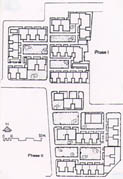
Project Features:
The project layout was composed of five rows of north-south oriented apartment buildings standing zigzag on both sides of Xiaosi Jie, the main access to the site, and the west and east boundaries of the site were enclosed by east-west oriented buildings, thus defining three introverted courtyards and isolating the site from the adjoining old neighborhoods.
The buildings were all four-story walk-up flats since the height limit for this area is 12 m. According to the designer, the project layout was dictated by the height control regulation and sunlight setback regulation. Building the maximum number of dwelling units within the permitted FAR limit resulted in a deep and narrow unit layout. A distinct feature here is that the individual unit layout is arranged according to the Hui custom. All kitchens had direct exposure instead of openings toward an enclosed light well, to accommodate the particular food preparation custom of Muslims. The placement of the washroom had the same consideration. Being a show case, the shared courtyards were well planted and managed, but they were rarely used by residents (Abramson, 1994). And many households enclosed their only private outdoor space - the balconies, for more usable space, security or privacy (Broudehoux, 1994, p.80).
Integration with the old neighborhood context was not a prime consideration in this project. On the contrary, to make the project stand out as a political showcase, some Muslim styled details decorate the otherwise ordinary facade. However to manifest the identity of its inhabitants in this fashion was to defy tradition because no such difference existed in the traditional courtyard houses inhabited by Hui people. 
The only sign for a Muslim home was probably a poster in Arabic letters on the gate. This was actually not only a characteristic of the housing, but also a characteristic of the Chinese tradition of not underscoring ethnic differences so that minorities could comfortably mingle with the mainstream society. In this sense, the deliberate segregation of this project was a break with tradition.
4.1.3 Case Study Three : Debao - Xicheng district
Debao was a typical old residential quarter within an old gateway area, where dilapidated houses abound. It was located outside the demolished Xizhimen gate in the northwest corner of the old Inner City in Xicheng district. The site was along the busy Xizhimen street and adjacent to Beijing Exhibition Hall, a popular public place. In the old days, the gateway area was the crossover place between urban and rural populace where market was formed for trade and exchange. Informal settlement was thus spawned, but generally in very poor and marginal conditions. The 5.2 hectares site was previously occupied by one-story structures and also by some shacks for builders of the Exhibition Hall in the late 1950s. A few minimal cost dormitory walk-ups were also cleared for the redevelopment (Sun & Kong, 1991). Beside having unsafe structures and over-crowding, the area was also very damp and unhealthy. Thus it became a First Stage renewal project in Xicheng district. The first stage of reconstruction was completed in late 1992, and 75% of the original residents were rehoused on site.
Financing:
The financial strategy in Debao was very similar to that in Huaibaishu. The project managed to build the utmost number of market-rate dwelling units and commercial space to achieve financial balance or even surplus. The price for returning residents was subsidized at 300 Yuan/m 2, payable in installments (Broudehoux, 1994), even so, very few residents bought their units. 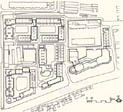
The market-rate units were mainly sold to the Ministry of Finance at 3,500 Yuan/m2 and a few left over units were sold through public bid, a new by-product of the real estate boom. The price sky-rocketed to as high as 7,000 Yuan/m 2. The original residents were rehoused in mainly east-west oriented dwelling units in two clusters on the south part of the site. The unit layout was tighter and the finishing quality was lower compared to the units sold at market price.
Project Features:
The renewal project consisted of four large compounds, each having a central communal courtyard. At the south-west corner, a two-story commercial building and the ground floor of the apartment building along Xizhimen street were reserved for commercial usage. Several east-west facing residential walk-ups with saw-toothed facades formed the enclosed courtyard.

The designers attempted to integrate the housing with Beijing's tradition through the courtyard layout of the compounds (Sun & Kong, 1991). In this case, the result was more successful than Huaibaishu because the communal courtyards were well defined and easily appreciated. Access was limited exclusively to residents, eliminating through-traffic and trespassing. However, the communal yards were over-sized, with as many as 350 dwelling units overlooking them, and they were hardly inviting. This could also be attributed to the lack of hierarchy of space in the sense that private and semi-private out door spaces were clearly missing.
4.1.4 Case Study Four: Hubeikou - Chongwen district
Hubeikouwas located in the north-east corner of the old outer city, in the inner side of the Second Ring Road. The site was a typical neighborhood adjacent to the demolished south side of inner city wall, which used to be an informal settlement of the urban poor. The site was full of densely built one-story courtyard houses and occupied an area of 5.22 hectares.
Financing:
The renewal project relocated all the original residents to peripheral settlements, and none of them was given the option to return (Broudehoux, 1994). The apartments built were large and comfortable and sold at about 6,000 Yuan/m2. The buyers were prestigious and well-off state owned work-units such as the Food and Oil Import-Export Company and the Foreign Commerce and Administration Corporation. Private purchasers were not accepted even though they might have sufficient funds (Broudehoux, 1994). Also included was a commercial office building. When completed, this 34,000 m2 building will also bring impressive income. From a business point of view, Hubeikou was undoubtedly a resounding success.
Project Features:
The residential buildings were south-north oriented and were arranged in zigzag layout to fit the oblique site boundary. Three point-block dormitory buildings for single employees were placed on the northern part of the site adjacent to the Second Ring Road. The unit layout and details were well designed. Each unit had a large living room which was connected to an enclosed balcony with a sliding door. The construction quality was top grade and included some new amenities such as the intercom at the entryway.
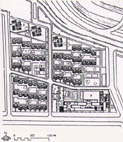
Invariably, the designer used sloped roofs and courtyards to integrate the project with its Old City environment (BJ Architects, 1991). However, the buildings with white ceramic tile walls and red-tiled roofs appear more colonial than traditional Chinese. The open spaces between two rows of residential buildings served to reminisce the ubiquitous courtyards. Though the designers used plants and pavement to outline the landscape, three dimensionally, the courtyards were still floating spaces lacking in definition.
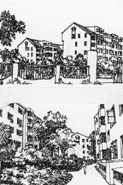
The compound was well managed. A gate with security guards limited the access of non-residents and ensured safety. Landscaping and furnishing were well arranged and maintained. The environment was quite pleasant and comfortable. The result could mainly be attributed to its high income residents, as a result of the complete off-site relocation of the original residents. In so doing, the developer concentrated on improving the quality of the physical environment in order to attract buyers willing to pay higher prices.
4.1.5 Case Study Five: Phase II of Ju-er hutong - Dongcheng district

The second phase of Ju-er hutong in Dongcheng district was located around that of the first phase, still within the super block thus not reaching the large streets in the perimeter. Except for its larger scale, the basic design principles and financing strategy all directly evolved from the first phase. Less than one third of the original households were rehoused on site, concentrating on one of the four clusters which was of comparatively lower standard in terms of finishing, amenities and unit size. Other newly built dwelling units were sold at market prices of about 4,000 Yuan/m2 to large and powerful work-units and well-off individuals. The developer regretted entering the housing market a little too early. If they had waited for a half year longer, the selling prices could have easily be as high as 6,000 to 7,000 Yuan/m2, given the location and reputation of the project.
[ TopOfPage(); ]
4.2 Observation of Stage One Projects
From the above five cases, scattered in the four urban districts, it showed although various local government and the development enterprises were encouraged to explore different approaches in housing renewal, the only applicable financial strategy was increasing the floor space which could be put on the market, because the profit from the sales of commodity housing or commercial space was the main source of revenue. Thus successful relocation of the original households became critical to the income-cost balance-sheet. Different districts approached this thorny issue with different attitudes, which led to radically different practices, from almost total rehousing on site to complete displacement to peripheral settlements. However, returning families were invariably treated to bare minimum amenities on their dwelling units.
The other projects completed and inhabited within Stage One of the housing renewal program employed financial strategies similar to the five projects described above. They differed mainly in the way they re-accommodated the original households.
A) Original households rehoused totally on-site
In the Huaibaishu project and Chunfeng Hutong, almost all the original residents were rehoused in their old living quarters after renewal. The original families were offered preferential prices, which were seldom more than one tenth of the market price. Even so, only very few could afford to buy. Most households stayed as tenants. The rent, though raised to 0.55 Yuan/ m2, still could hardly cover the maintenance cost. Some later projects introduced a "rent deposit", around 40 to 80 Yuan/ m2, which would be refunded to the households after several years while the interest helped cover the maintenance cost.
If we could introduce a concept as Extra Area Ratio (EAR), which is defined as: EAR = (An - Anr)/An, An is the total floor area after renewal, Anr is the area for rehousing the returning households. He Hongyu estimated that the EAR should be higher than 0.3, to break even the redevelopment cost (He Hongyu, 1993). In other words, returned residents could take up to 70% of the renewed dwelling units.
B) Partial on-site rehousing
In the Ju-er Hutong and Debao project, some of the original households were rehoused on-site while others were displaced to suburban settlement. The return rate ranged from 20-70%. In some projects like Ju-er hutong, households could move back only if they were willing to buy their new units (Zhang Jingjin, 1992). This pre-condition effectively limited the returning rate.
Developers also provided favorable conditions to induce residents to move out, usually people could get much more spacious and better quality units if they moved to suburban settlements. Why so? Because developers could take advantage of the land value difference of renewal parcels for their central location, which more than compensated the cost of the better units in the suburb. This will be shown more clearly in the economic analysis in the next chapter.
C) Total displacement
The other extreme practice was to relocate all the original households, generally to far suburban settlements. Hubeikou chose this model. Since the new relocation rule was introduced, this total displacement could only happen in some special cases. For example, in the areas where zoning control was very strict, e.g. height limit was only 6- to 9-meters, EAR was near zero if all the original residents were to be rehoused on-site. Other cases might occur in the areas where land-use was to be changed to public or commercial purpose (He Hongyu, 1992).
D) Commercial development cross-subsidizing housing regeneration
In the cases of Xiaohoucang and Debao , a portion of the redevelopment parcel was converted to commercial development, whose higher market price in turn brought higher profit. This rather lucrative proposition could only happen in larger projects and in locations which were conducive to commercial conversion. Therefore this model was not applicable to every redevelopment parcel, either because the location was hidden in the heart of a residential area, or because of the strict land-use zoning and governments' control on financing public office buildings (He Hongyu, 1993).
For the projects of Stage One, besides being almost all on larger sites, other common features were that they generally enjoyed easier access to infrastructure, had a larger portion of commercial space and a higher and denser site layout after renewal. All these features were conducive to lower development cost and higher investment return. In addition, they also relocated a higher proportion of original households to peripheral settlements. Their spatial composition differed according to location. Generally, the projects outside the Second Ring Road were composed of six-story high walk-up slabs, whereas projects within were governed by the height limit as specified. A new regulation implemented in 1987 to strictly control the building of residential high-rises resulted in, all residential buildings not exceeding six-stories no matter what the specific height limit might be, unless a special permit was obtained.
[ TopOfPage(); ]4.3 An Official Evaluation
In the first quarter of 1992, a seminar was held among the design institutions involved in Stage One renewal projects. At that time, of the 37 projects, 10 projects had been completed and occupied and 17 projects were under construction, another 9 projects had completed the design process and were preparing to start construction, only one was still being designed. Cheng, director of the Municipal Old and Dilapidated Housing Renewal Office, reviewed the renewal projects in Stage One. If his evaluation could be taken as official remarks, the government's stand and concern on this issue can be interreted through his observation and evaluation. The merits and disadvantages he observed were sumarized as follows.
For the merits of these projects, the first was their integration with context and emphasis on improving the living environment. Most of the renewal projects adopted a spatial layout of several residential building centered around a semi-public courtyard, which was considered progress from the conventional rowed arrangement in new residential development. These projects reaffirmed the principle of 'comprehensive development'; each of them had a "complete set" of coordinated public amenities (Cheng, 1992). Many of the projects were praised for their efforts to give the building facade distinct identities: Huaibaishu for its light gray masonry walls and dark gray roof tiles - reflecting the traditional colors of Beijing, Hubeikou with its floating red roofs and white walls - standing harmoniously with the adjoining highway overpass, multi-story courtyard Ju-er hutong - reinventing the traditional taste of tranquillity and propriety. Chunfeng hutong was especially appraised by Cheng for the efforts it made respecting its Hui inhabitants, which were reflected in both the interior layout design and the exterior decoration.
The second merit was the improvement of unit layout design. The new layouts had enlarged living room, kitchen and bathroom. The size of bedrooms was reduced and storage spaces were increased (Sanda, Yiduo, Yixiao in Chinese). This new layout was deemed more suitable to the changing lifestyle. Some projects allowed residents to participate in certain decisions such as choosing the interior finishing and even in some cases the infill walls. In so doing, the adaptability of the dwelling units was increased.
As for the pitfalls of the renewal projects of Stage One, Cheng pointed out, first was that pursuing higher FAR resulted in too high a population density in some projects. Though the residential density of 600-800 capita/hectare was recommended, some projects had reached a density of 900 and in one extreme case it even went over 1,000. That meant the general living environment was even more congested after renewal, which was in conflict with the Master Plan (Cheng, 1992).
Another problem was that the units reserved for returning households were generally very small and of low quality (Cheng, 1992). In promoting the renewal program in 1990, the Mayor of Beijing was hoping that renewal would cure dilapidation and over-crowding at once; that after renewal, each household would live in a decent, self-sustained dwelling unit reaching the xiaokang standard (Lü Junhua, 1994, II). However, the reality was not so optimistic. The rule most renewal projects followed for rehousing was: if rehoused on site, the new unit was the same size as the demolished (jie wei bu jie kun, in Chinese); if relocated off site, generally on the outskirts settlement, the unit size was guided by the Relocation Act, which compensated for the increased distance to city center by granting more space. In fact, for many families rehoused on site, the living space was even smaller than before, because the self-built additions, about one fourth to one third of the demolished home, were not taken into account in the exchange.
The third problem was that, pursuing higher FAR resulted in many bad designs, such as the inappropriate location of doors and service pipes, too long and narrow passages, bad ventilation, as well as unfit layout for privacy and security. These poorly designed units were mainly reserved for returning households.
[ TopOfPage(); ]4.4 An Evaluation of the Official Evaluation
The observation and evaluation of Cheng were limited only to the physical environment of renewal projects. He applied the same standard of general housing development to housing regeneration in the Old City, not paying any special attention to the cultural and historical context.
Basically, his evaluation was based on the performance of these projects on fulfilling the goals of the renewal program, mainly to improve the housing conditions of the residents in dilapidated old residential quarters and to protect, or to integrate with the Old City image through the renewal. All the merits and disadvantages were centered around these two issues, but sadly, he failed to touch the core of them.
Generally speaking, the Chinese government's concerns on the issues of housing were limited to the unit size, interior layout, basic facilities and population density. These were only the physical conditions of residential area after renewal. Given the high rate of resident displacement in some projects, these new physical environments were mostly irrelevant to the original households. Further, residential environment did not only mean the material conditions; social infrastructure was also an important aspect.
As for the issue of city image protection, it seemed that either there lacked a fundamental standard by which to base the evaluation, or there was no specific concern for this issue in the renewal projects in the Old City. The conservation of the main hutongs in the renewal parcel, the clustered building layout with a central communal courtyard was supposedly a tribute to the Old City context, when actually, this might be only a result of the efficiency of circulation and the pursuit of a high FAR. The decorated facades, as described above in the case of Chunfeng Hutong, were incongruent with the context, both physically and historically.
Cheng's evaluation showed that actually, the priority of government's concern was to facelift these dilapidated quarters, to modernize the image of this ancient capital. The improvement of people's living conditions was limited to the physical sense; the socio-cultural impacts of large scale urban renewal were ignored. Cheng didn't even mention the relocation settlements where most of the original households moved. Even city image preservation was only superficial; practically it was do-whatever-you-want under the height limitation, and even this one regulation was frequently challenged (Lü Junhua, 1994, I).
The evaluation did not directly touch upon the most sensitive issue of housing regeneration, the re-accommodation of the original residents, but its importance was nevertheless reflected through other problems. Indeed, all the three defects Cheng observed had to do with rehousing the returning families. The excessive population density and the inappropriate interior layout were the result of pursuing higher FAR, the small size and low quality was to reduce the cost. All were aimed to balance the heavy economic burden to provide the original households decent dwelling units. Thus, it was unfair to compare the physical outcomes of renewal projects without taking the on-site rehousing rate and economic performance of each project into consideration.
In fact, each district confronted different situations from the beginning, thereafter housing renewal ranked in different priority on district government's agenda. Xuanwu district had the worst living conditions among the four central city districts. Around four km2 was dilapidated in its total 16.53 km2 jurisdiction area; an equivalent of about one fourth of the entire district needed to be renewed. Therefore urban renewal was among the priorities of the district government. The six Stage One projects within Xuanwu district had all been completed and inhabited by the end of 1993. 27 parcels in Stage Two had also been under preparation. One project was already under construction (Li Zhao, 1994). Each district government assumed a certain stand on fulfilling the housing renewal tasks, which was manifested in the way the original residents were treated. In Xuanwu district, on-site rehousing was as high as 81.27% (Cai 1994), while other districts barely exceeded 30%.
Relocation became a politically charged issue in that people started to oppose the renewal of their neighborhood if they would be displaced. That was a sharp turn from the initial warm welcome when on-site rehousing was guaranteed. Many intellectuals also criticized the radical solution of total displacement. They worried about the impacts on the historical city through this complete remaking of both environment and community (Lü Junhua, 1993, II). To balance the social impact and economic pressure, the municipal government announced a new regulation on renewal projects that each project must accommodate no less than 30% of the original households on site, which was only a token gesture to show the government's concern on this issue. This number quickly became the target maximum on-site rehousing rate for developers, and the housing clusters for original households were generally segregated from the commodity clusters.
[ TopOfPage(); ]4.5 More Recent Projects:
Since 1992, real estate development had become an independent and contributing sector in state economy. The building boom ballooned the market price of commodity residential housing dramatically in Beijing, which made the renewal projects, thanks to their central locations, attractive to development compa nies both domestic and foreign. Meanwhile, the municipal and district government seized the opportu nity to have the renewal carried out for financial gains.
In order to guide the property boom toward fulfilling the demand for affordable home of average families, Beijing decided to allow foreign companies to invest in the reconstruction of the old district and to sell redevelopment property to local companies and individuals - a policy designed to attract foreign resources into the urban renewal program (Lau, 1994). In late 1992, a large delegation, including representatives from all four central districts, went to Hong Kong to solicit more foreign investment for many projects, which ranged from agriculture, industry, transportation, telecommunication and real estate development. Among these there were seven renewal projects from the four central districts, most to be redeveloped for commercial purpose (Cai, 1994).
Projects within Stage Two and Three of the renewal program mostly lay along the Second Ring Road, Qiansanmen street and other major thoroughfares. According to the city Master Plan, after renewal, all the major arteries inside the Second Ring Road would be widened and the strip of land along those widened streets would be reserved for public or commercial usage. The development of the parcel of land for public or commercial usage was generally separated from the development of land mainly for residential usage. Foreign investment concentrated in commercial projects, which were more profitable.
4.5.1 Case Study Six: Chaonei Area Dongcheng district
The Chaonei renewal parcel was in fact a whole typical super block, which was approximately square in shape and 41 hectares in area. This super block was defined by two major streets: the Second Ring Road along the east side and Chaoyangmennei street along the north side, and two medium-width streets along the west and south sides, namely Chaoyanmenneinan street and Dafangjia hutong. Considering the subway station on the north-east corner, this parcel enjoyed all levels of transportation service. Access to all the utility pipes were easy, because the urban infrastructure beneath Chaoyangmennei street and the Second Ring Road was already in place and capable of handling the needs of redevelopment.
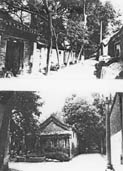
There were 23,181 residents in 8,768 households in this area, who enjoyed all the benefits of urban living in Beijing. Convenient transportation, easy access to the city's central shopping streets - angfujing and Dongdan are less than 1.5 kilometers to the west, the emerging CBD in Chaowai area was just across the Second Ring Road, cultural amenities such as the National Art Gallery, the Workers' Sta dium, Ritan Park were very near. Good hospitals and schools were also within walking distance ( Lü Junhua, 1994, II).
The housing conditions in this area were generally poor, according to a survey conducted by the Dongcheng district's Housing Management Bureau, the total housing floor area in the Chaonei area was 219,000 m2, of which 35% were in class III and 45% in class IV or V. Together the "old and dilapidated" houses amounted to about 80% of the total, which, according to the criteria of dilapida tion, ranked the parcel in high priority for renewal ( Lü Junhua, 1994, I).
Design Process:
In the years before the current renewal program started, this area had been planned for redevelopment several times. In 1987, a delegation from then West Germany proposed a preservation oriented scheme which sought to preserve residential land use, the current circulation system and most of the courtyard houses. As to relieve over-crowding, 40-50% of the original households were to be relocated. In contrast, a design team in 1988 called for complete demolition - redevelopment, because this team thought the one-story courtyard neighborhood was out of context in the sense of time and place. The two schemes they proposed, one with 62% of floor space in high-rise and the other with 34%, allowed most of the existing residents to return after renewal (fig. 4.19). The designers argued that the self-sustained dwelling units in high-rises or walk-up flats were the housing type people needed in contemporary society, and courtyard housing as a building type had lost its validity (Han Aiping, 1988).
Neither of these two proposals could be implemented now, the first for being financially unrealistic - there was no economic incentive for any of the participants; the second for its emphasis on high-rises which were against the new regulation prohibiting high-rises. In 1992, a team headed by Prof. Lü Junhua from Tsinghua University was commissioned to re-plan and design this area.

A Detailed Control Plan was issued by the Beijing Planning Institute giving guidelines for the specific requirements (Lü Junhua, 1994, I). According to the plan, a new 25-meter wide service road needed to be arrayed parallel to the Second Ring Road and about 200 meters to the east of it, the fifteen-hectare strip of land thus formed was zoned for public or commercial buildings of up to 45 meters in height with a 60 meters tower at the north-east corner. The remaining 26-hectare of land in the west part was for residential usage, with a height limit of 18-meter and a floor area limit of 290,000 m2, a district level shopping center needed to be placed at the north-west corner. The south boundary of Dafangjia hutong and the third east-west lane from north needed to be widened to 25-meter ( Lü Junhua, 1994, I).
The design team was commissioned only for designing the residential quarters in the west part. The east part would be further subdivided into several lots for different developers. The design team pro posed two schemes, a "low-rise" scheme composed of houses mainly in two-to four-story high and a "mid-rise" scheme of five- to six-story high.
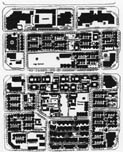
According to their study, housing under four stories had distinct advantages in merging harmoniously into the Old City fabric. This building height could host various housing types from quasi-courtyard housing to townhouse as well as walk-up slabs. Given the simpler construction techniques involved, the low-rise housing had great flexibility for future renovation, which could grant the would-be inhabitants more possibility for future customized transformation (Lü Junhua, 1994, I). However, the problem of this scheme was its difficulty to reach the floor area of 290,000 m2, which was the maximum floor area permitted by FAR and requested by developer to be the practical minimum. Therefore, some high-rises were added on the periphery of the parcel (fig. 4.20).
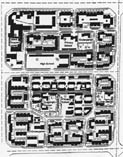
The other alternative, the mid-rise scheme, more closely followed the requirements of the planning authorities and the floor area demanded by developer. The scheme was mainly composed of five- to six-story high walk-ups (fig. 4.21). Generally speaking, the spatial environment of this type of housingthe building mass coupled with the greater distances in between required by the sunlight regulation, was over-scaled compared with the original environmental fabric of hutong-courtyard housing neighborhood. In addition, this housing type was most commonly used in the green field development, if it prevailed in the Old City, there would hardly be any difference from the periphery settlements. In short, this housing type was not conducive to city image preservation.
However, eventually the mid-rise scheme was approved by the planning authority and accepted by the developer. The planning authority rejected the low-rise scheme for its occasional violations of the six-story height limit and the narrow spaces and high ground coverage, which was thought would handicap the installation of standard infrastructure pipelines. For the developer, the higher floor area potenial of the mid-rise scheme was preferred.
Although the designers did their best to advocate the advantages of their preferred low-rise scheme, they had to develop the mid-rise scheme as the working proposal. They tried hard to avoid an environment formed by uniform five- to six-story slabs by breaking up the building mass, and varying the roof shapes (Lü Junhua, 1994, I). Though they had to widen some of the hutongs, they retained others as pedestrian paths in respecting to the old fabric. In all these efforts, however, they regretted being forced to change the spatial environment and the image of the old capital.
Ironically, after the planning scheme got approved by the planning authority, the developer tried to shift to another design institution (from conversation with Lü), because it could force the other designers to reach a even higher FAR based on this approved scheme.
4.5.2 Case Study Seven: Guanganmen Avenue - Xuanwu district
Xuanwu district, one of the four central urban districts, occupied the south-west part of the old Beijing. Historically, this was a district dominated by urban poor. It had the highest population density among the four districts, housing 550,000 people in its 16.55 km 2 jurisdiction area, an average of 33,000 capita/per km 2. Its living conditions were also the worst. Houses in class IV or V made up to 40% of the total, and families in housing difficulty composed about one third of the total households in the district (Li Zhao, 1994). Average per capita living space was one square meter less than that of the other three districts. Infrastructure was also the poorest, e.g. drainage canals were relics from the Ming Dynasty (Cai, 1994).
The six Stage One projects in Xuanwu district, except for Chunfeng hutong, were all along the West Second Ring Road, from where all the high capacity utility lines could be reached. But the parcels of further Stages were located in the interior of the district, and it was more difficult to conduct renewal on these parcels given the very high population density, bad circulation and poor access to urban infrastructure. In response, Xuanwu district government proposed a scheme of "widening the streets and preparing the infrastructure first and then redeveloping the adjacent parcels". The commercial parcels along the widened streets were pre-leased to various developers in order to finance the street widening and infrastructure installation (Li Zhao, 1994).
Redevelopment of Guanganmen Avenue was such a case. This 4,050 meters long avenue was the central axis of Xuanwu district and also a planned major east-west traffic artery of the city. The district government offices, most of the shopping centers and cultural institutions were also along this avenue. The avenue had been widened from a former 26-meter width to 70-meter, along which public or commercial buildings of 24- to 60-meter height were to be erected. There were ten dilapidated residential parcels to be renewed along both sides, three outside the Second Ring Road and seven inside. Just the seven parcels within the Old City occupy up to 168 hectares urban land, with 21,000 households living in 1,250,000 m2 of floor area (Liu Su, 1994).
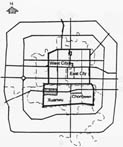
The principle for planning and design was "plan together and implement independently" (Liu Su, 1994). As in the Chaonei area, a Detailed Control Plan was also prepared as the guideline. According to the plan, first the avenue would be widened to 70 meters. Vehicular lanes, cycling lanes and pedestrian sidewalks were all separated by strips of greenery. Secondly, all the infrastructure pipelines would be installed beneath the pavement, including two telecommunication cable systems, two pipelines for water supply, line for gas, rain water drainage which was separated from waste water drainage, power line for electricity supply and pipeline for central heating. 
Second, in order to relieve traffic jams in the area, several north-south secondary streets of 25-meter width and service streets of 15-meter width would be added. As the result, the circulation network density 3 would increase from 3.9 to 5.2 km/km2. Thirdly, the land use of the area would be adjusted. Along the widened avenue, 35 large public or commercial buildings with a total area of 1,700,000 m2 would occupy 37.5 hectares of land, which amounted to 22% of the whole renewal area. Land designated for circulation, public squares and green space would also be increased. Circulation land use jumped from 10 hectares to 36 hectares, and land for public squares and green space was increased to 5.6 hectares from nothing 4. Buildings for utility service also occupied more land. An electricity transformer substation, a telecommunication station and a fire department would take up a total of 1.6 hectares of land. Simultaneously, land for residential usage decreased dramatically from 92 hectare to 32.2 hectares, only 19% of the total district after redevelopment. This measure was aimed at reducing the population in central areas demanded by the city's Master Plan (Liu Su, 1994).

Till now, the widening of the avenue and the installation of the infrastructure pipelines had already been completed. Several large public projects were under construction (fig. 4.24), and some renewal parcels were in preparatory stage. From this case, it was clear that renewal encompassed more of a physical overhaul of the city's image than an improvement in the living conditions of the residents. The district government needed a modernized streetscape to show that economic prosperity had replaced the "dilapidated and obsolete" old image.
[ TopOfPage(); ]4.6 The Shifting of the Goal
The above two case studies for the projects in later Stages show how the direction of the program has diverged. At the beginning, improving the original residents' living conditions was the prime goal; the program to some extent was a sort of welfare undertaking by the government. However, when the program was promoted in large scale, it became multi-faceted urban renewal instead of neighborhood regeneration. Subsequently, it shifted its target from original residents to the physical environment, from improving their living conditions to improving the appearance and profitability of the dilapidated residential quarters. Further, under the pressure of the real estate development boom, land, instead of its inhabitants, became the central point of the whole renewal program. Improvement of original resident's living conditions was only incidental. In so doing, a social program designed to help an under-privileged low-income group of citizens evolved into pure profit-oriented real estate redevelopment.
In reality, right from the beginning, improving the living conditions of the original residents, the main goal of the program, was very hard to accomplish. The key issue of the housing renewal program was financing. The municipal government barely provided any financial support, and though the district governments were the main coordinators of the program, they also lacked the funds for housing renewal. The cash input from the original residents was also very limited as shown in the previous case studies; only very few households bought their new dwelling units although the sales price had been heavily subsidized. The unrealistically low rent did not induce people to own their dwellings. The housing renewal program started as a public assistance program aimed to improve the residents' living conditions without their own financial input, but the scarcity of resources from the governments hampered the viability of the welfare undertaking.
Investment from development agencies was actually the only resource. But developers of regeneration projects were not philanthropists; they invested for profit making. That was to say, there must be a way for their investment to realize an "economic beneficial cycle" through renewal process (Lü Junhua, 1994, I).
This profit needed to be paid by those who benefit from the process. Who actually benefited from the renewal process besides developers? From the analysis of each participating player's interests, it showed that the different levels of government, the final occupants of the renewed housing all gained. For the governments, the renewal process helped them realize administrative achievement, updating the city image and stimulating the local economy without capital input. In the current property boom, they even got financial gain from the renewal process, either in cash or in real estate property. For the final occupants, either in-coming households or returning original families, they got better accommodation in a very convenient central city location. As for the displaced households, the question " did their living conditions also improve?" was difficult to answer. Some thought they did because the physical environment did improve substantially, while others argued that physical condition was not the sole indicator of quality of life; the displaced actually lost in the game because all the conveniences they once enjoyed were gone. If the answer could be based on the residents' satisfaction, then the result could probably be negative, even for the households which were rehoused on site. However, the residents' satisfaction itself was too subjective a topic to discuss, because it was related to too many marginal circumstances. The general dissatisfaction of the original residents showed, at least, that they were not the main beneficiaries from the renewal process as they once assumed.
Among the four main players in the housing renewal program, the two levels of government became the largest winners. Instead of paying for the program they actually got financial revenue from it besides achieving their political and administrative objectives. The developers also gained profit from their investment, usually in a high rate of return. The situation of professionals was a bit varied: some project designers were happy in that they got the project built and made money from it, though some who care about the historical preservation were concerned that the Old City would continue to erode and finally disappear. The residents reacted differently according to their individual interests: the newcomers were happy in their new environment enjoying a central location; the returnees felt cheated for their second-class treatment; the displaced were bitter about being forced-out of their former centrally-located neighborhood. They felt that they were the victims of the whole game.
It seems the self-supporting housing renewal program is proceeding at the cost of the Old City image and original residents. But this fact is not acknowledged by the governments. From their point of view, every sector gains from the renewal process, that even the relocated households enjoy " xiaokang" standard decent dwelling units which they can hardly afford on their own. City image protection, which is too difficult to define and too long-term a problem to consider, is not taken seriously. But it is exactly on these two issues, the preservation of Old City image and the re-accommodation of original residents, that the merits and evils of the housing renewal program must be judged. These are the topics of the next chapter.
1Chunfeng hutong was an exception because its specific political status.
2 The practice of Jian feng cha zhen, or stick in a needle wherever there is room.
3 This is the rate of the total length of circulation network within a district to the area of that district (km/km 2) (Li Wei, 1992).
4 Traditionally there was no public open space in Chinese City planning, while every family had their courtyards as open space at family level. The notion of public green space was introduced by city planners as progressive idea for a modern city.
[ TopOfPage(); ]